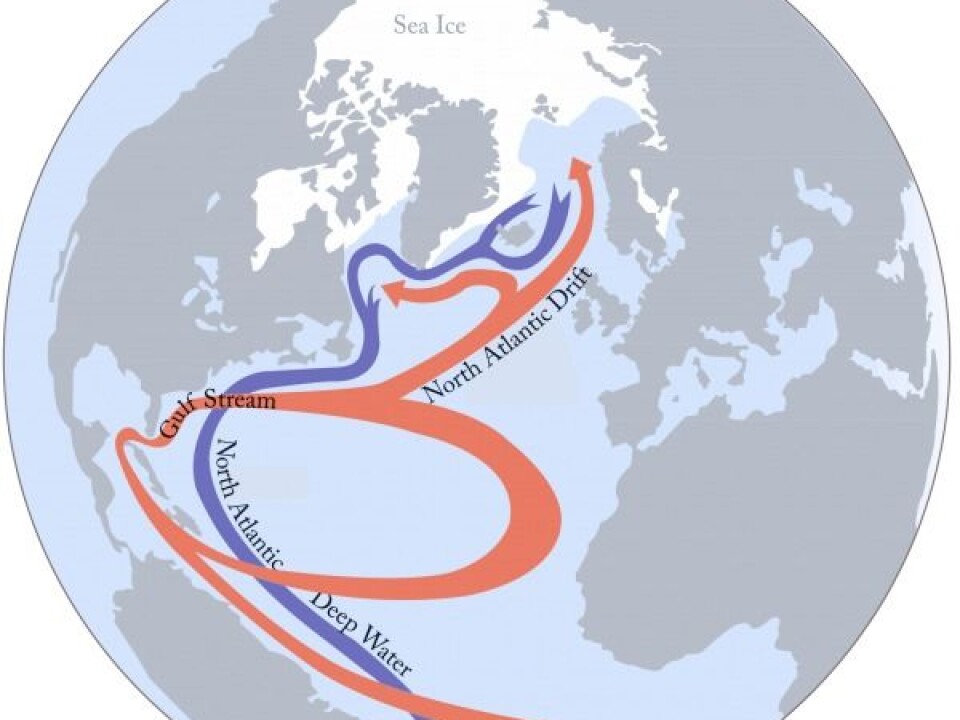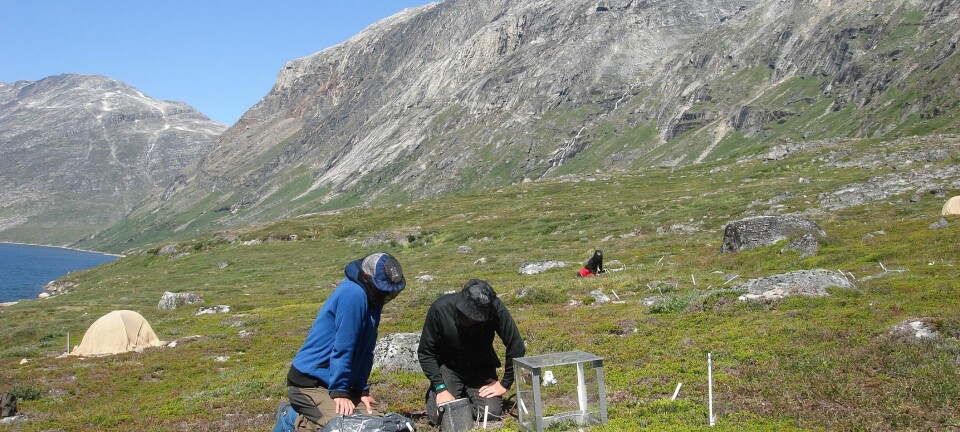
Is a vital pattern of ocean circulation about to shut down?
A new study indicates that current climate models overestimate the stability of a vital ocean circulation in the North Atlantic. A breakdown could mean a “chaotic” climate in the Nordics, say scientists.
A new study has been making headlines around the world and has spurred news reports that Europe and the US could be headed for a “major freeze” or “icy apocalypse”.
The study, published in Science Advances, discovered that existing climate models may be overestimating the stability of a vital pattern of ocean circulation known as the Atlantic Meridional Overturning Circulation (AMOC).
This circulation currently brings warm water from the Tropics to the North Atlantic, keeping Northwest Europe much warmer than it would otherwise be.
The climate model experiment showed that doubling the concentration of atmospheric CO2 above the 1990 level, could invoke a slowdown and eventually a complete shutdown of this ocean circulation. This would cut off the flow of warm water and weather to northern Europe, and make the Nordic countries up to seven degrees cooler, and drier.

It is certainly dramatic, but could it really happen? And how does it fit with what scientists already know about this vital system of ocean circulation?
We spoke to three AMOC experts in Denmark and the US who unanimously agreed that there is no evidence that the AMOC will collapse any time soon. Neither Europe nor the US are not about to enter an “ice apocalypse.”
But, the future stability of the AMOC as the Earth warms is a cause for concern and a topic of fierce scientific debate.
Read More: Modern industrialisation killed ocean cooling
What is the AMOC?

The AMOC can be thought of as a large ocean conveyor belt where cold water in the North Atlantic and the Labrador Sea sink to the ocean depths and flow south, back towards the equator. This is balanced by surface winds that draw warm, salty water from the Tropics back north, often simply referred to as the Gulf Stream.
En route, these salty surface waters cool and mix with fresher northern waters, which keeps the AMOC conveyor belt turning.
This conveyor belt will remain “switched on”, so long as the balance of fresh and salty water in and out of the Atlantic Ocean is maintained. But, if the balance is upset, the conveyor belt could slow down and even “switch off” entirely.
“Geological evidence tells us that at least in some climates, such as during the last ice age, the AMOC most likely had two stable states either on or off, which theoretically could apply in the future,” says Research Leader Steffen Olsen, who studies the AMOC as part of his research at the Danish Meteorological Institute (DMI).

Read More: Greenlandic fjords get their organic matter from Russia
Has the AMOC slowed down already?
Predicting whether the AMOC could switch between these two states in the future, is tricky. Successful predictions rely on having extensive data that show what the AMOC has done in the past. Unfortunately, there relatively little data available.
“We have a system of instruments in the Atlantic, at 26oN, which give us a unique view on present circulation and possibilities for change. But it’s very limited. We only have a decade of observations. So we’re very careful about commenting on it,” says Olsen.
These data, along with other ocean observations that cover the past 30 years, show that the strength of the AMOC varies significantly from year to year. So much so, in fact, that there is not yet any sign of an undisputed long-term trend, though reports vary.
Even so, most climate models predict a gradual weakening of the AMOC over the next few decades, though the AMOC will remain relatively stable with no complete shutdown in sight, according to the latest IPCC report.
“The best consensus is that we will affect the circulation. Parts of it will still be active, though under pressure, and a gradual decline in circulation is more realistic than any abrupt change,” says Olsen, adding that “it’s still something to be concerned about.”
Read More: Melting Greenland ice has not slowed down ocean circulation
The new study: Climate models overestimate AMOC stability
But the models have a fundamental flaw when it comes to predicting the AMOC.
The balance of freshwater in the Atlantic, as represented by climate models, does not match observations measured by scientists.
“The models are not perfect. In the mean climate, described by these model systems, they have a freshwater bias in the South Atlantic, which means that the Gulf Stream basically brings in too much fresh water to the North Atlantic,” says Olsen. “This is most likely in contrast with what we know from observations.”
This may make the models favour a stable, active AMOC, and underestimate the possibility of a slowdown or even a complete switch off.
In the new study the scientists correct for this, so that the model comes up with a more realistic picture of ocean circulation in the North Atlantic.
Read More: Climate models underestimate rapid ice melt events on Greenland
Complete shutdown 300 years after doubling CO2
They then tested both the corrected version of the model and a regular, uncorrected version to see what happens to the AMOC in the future after increasing atmospheric CO2.
This is called a sensitivity experiment. It is not designed to make firm projections of the future, but to test how sensitive the climate system is to any substantial changes such as increasing greenhouse gases.
In both simulations, they doubled the amount of CO2 above the 1990 level, and then let the model run.
While the uncorrected model showed a weak slowdown in AMOC, the corrected model gradually declined and finally switched off around 300 years after the CO2 increase.
“The collapse is not abrupt, it’s a gradual slowdown over centuries, but it’s significantly different from what they see in the unadjusted model,” says Olsen.
Read More: Greenland Ice Sheet has already caused nearly five metres sea-level rise
How would such a shutdown affect the Nordics?
So how could this affect weather patterns closer to home?
“We know for a fact that it will have significant climate consequences for part of the Northern Hemisphere, in particular in the ocean regions and Scandinavia,” says Olsen.
Could Denmark really be on track for an ice apocalypse?
“The impact on the Nordic countries is going to be complex if we allow the shutdown to occur,” writes climate modeller James Hansen from Columbia University, USA, in an email to ScienceNordic.
But it’s definitely not the first step into an ice age, stresses Hansen. Instead, it will be a complex interaction between the cooling effects of the disappearing AMOC and global warming.
“The planet will be getting warmer and so it will be chaotic at high northern latitudes,” he writes.
Jens Hesselbjerg Christensen, research leader at the Danish Meteorological Institute (DMI) and adjunct professor at the Niels Bohr Institute, University of Copenhagen, Denmark, agrees.
“We know that it’ll modify the energy uptake of northern oceans. If it happened right now then we would get a substantial cooling, but if it happens along with a general warming, then it’s more likely that it won’t dominate the whole region, and it will compensate for some of the warming,” he says.
Read More: Declining winter sea ice near Greenland spells cooler climate for Europe
The jury is still out on the future of the AMOC
Unlike the existence of man-made climate change, the future stability of AMOC is a genuine topic of scientific debate, which often leads to conflicting reports in popular media.
Scientists have known for decades that AMOC is a major player in the global climate system and vital for keeping Northwest Europe warmer than it otherwise would be. But figuring out whether it has already slowed down, how it may change in the future, and what it would take to cause a complete shutdown is much harder to pin down.
“We need to investigate why the models are so stable. They’re perhaps a bit ‘too stable’ because in the real world there are large variations, which are not caught by models,” says Christensen.
The new study does contain all the answers.
“It’s not good enough to just see it in a model, we need to know the process behind it. We can see that process if we hit it with a sledge hammer, but we don’t have a sledge hammer, we have something that can produce gradual changes,” he says.
The sledge hammer that Christensen refers to is in part the way in which the model experiment uses an almost instantaneous doubling of atmospheric CO2. This is much faster than the already dramatic increases in CO2 seen since the beginning of the industrial revolution.
The new study predicts a slowdown and eventual shutdown of the AMOC if atmospheric carbon dioxide is doubled from the 1990 level. Here you can see the history of atmospheric carbon dioxide per month since 1958. Hover your mouse over the curve to see how carbon dioxide has increased through time. The 1990 level was approx. 355 ppm. Today it is approx. 405 ppm. The new study is looking at levels of around 710 ppm. (Graph: ScienceNordic.com / Videnskab.dk)
What do scientists need to do now?
The take-home message from Christensen, Olsen, and Hansen, is that there is still a lot of work to do before we can accurately model the AMOC and how it may impact the climate around the North Atlantic.
“This is a useful contribution, but they don’t fix the problem in ocean models,” writes Hansen.
“The projections of climate change by the community--the models used by IPCC--generally do not include the most important forcing--fresh water from melting ice,” he writes.
Highlighting the ongoing scientific debate around the future of the AMOC, Hansen takes a more dramatic outlook than the gradual slowdown suggested by Olsen and Christensen.
“If we let the world get much hotter you can kiss goodbye to a good part of ice sheet and look forward to a shutdown of the AMOC and a hell of an interesting climate in the Nordic countries.”
Scientific links
- Overlooked possibility of a collapsed Atlantic Meridional Overturning Circulation in warming climate









